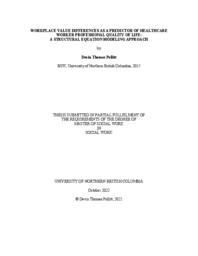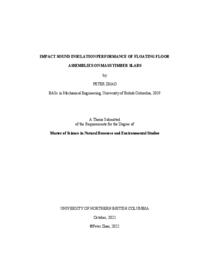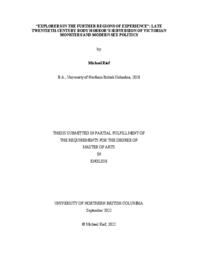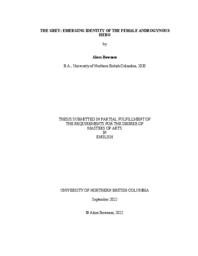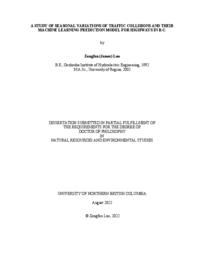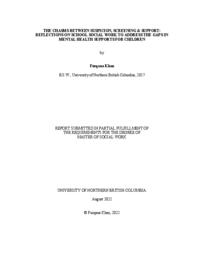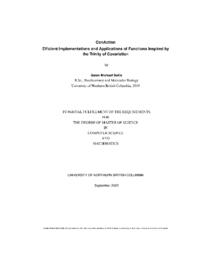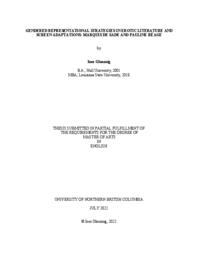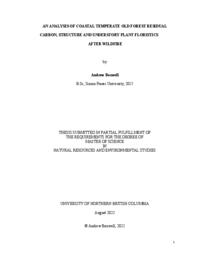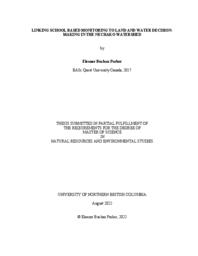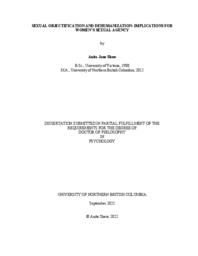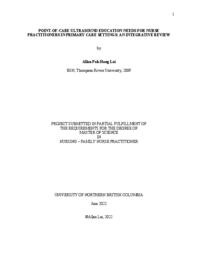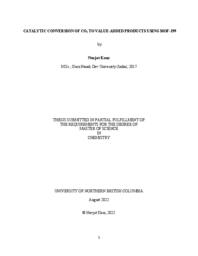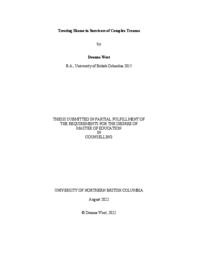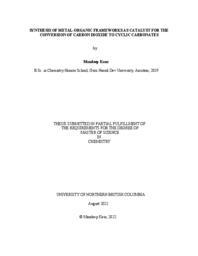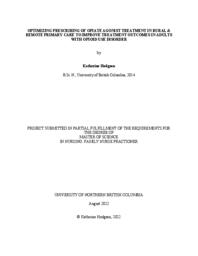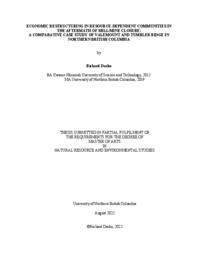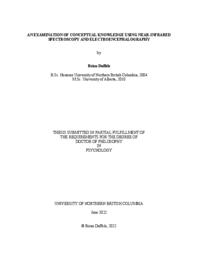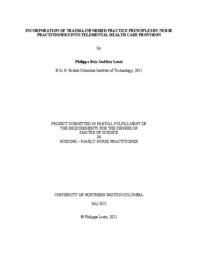University of Northern British Columbia
Related Works
Content type
Digital Document
Description / Synopsis
The purpose of this research project is to create an educational tool in the form of a children’s book. My aim is to spark discussions regarding equity, inclusion, and identity for children ages four to six-year-old. This research project proposal is divided into six chapters. Chapter One introduces the framework for the proposed case study. Chapter Two provides a literature review, exploring the relationships between bibliotherapy, animals and people. Chapter Three provides a description of the qualitative methodology and description of the method process. Chapter Four outlines the findings and evaluation of the case study. Chapter Five describes the proposed children’s book manuscript and future aspirations for Through the Eyes of a Dog. Chapter Six presents the lessons learned and recommendations based on the research journey.
Origin Information
Content type
Digital Document
Description / Synopsis
This MSW thesis explores workplace value differences as a predictor of healthcare worker professional quality of life. Secondary data analysis was performed on data previously collected on hospice and palliative care workers in a 2013 Pan-Canadian Study. The fit of a theoretically informed model to the dataset was analysed, exploring empirical support that healthcare worker value differences within the workplace accounts for a significant part of the variance in their levels professional quality of life. In the Pan-Canadian study, measures of professional quality of life included the Professional Quality of Life Scale (ProQoL). Additionally, the Nursing Unit Cultural Assessment Tool (NUCAT) was also used. This study reviews the pertinent literature, articulates the model suggested above by exploring existing evidence and theory, and tested the model fit using a structural equation model. Understanding the impact that workplace factors have on healthcare worker professional quality of life is an important area of research. Further research utilizing structural equation modeling may help increase our understanding of the multi-factorial nature of professional quality of life measures and its impact on workers, patients, and families.
Origin Information
Content type
Digital Document
Description / Synopsis
Mass timber buildings become increasingly popular in North America and worldwide. Mass timber panels are mainly used structural slabs in mass timber buildings. However, due to the lightweight and low-stiffness of mass timber panels, the human induced impact sound on floors has been identified as an issue to be solved. Floating concrete topping is a common solution adopted for insulating the impact sound transmission through the mass timber slabs. However, there is few guidance on designing floating concrete floor assemblies and high performance floating floor assemblies for mass timber slabs. In this study, the relationship between concrete topping thickness, dynamic stiffness of elastic interlayers and the impact sound insulation performance of continuous floating concrete assemblies was first investigated according to ASTM test standard. It was found that the floor assemblies with lower apparent dynamic stiffness of elastic interlayer and thicker concrete topping had higher apparent impact insulation class (AIIC) ratings, but limited under 53 dBA without additional floor finish. The empirical prediction equation overestimated the improvements of floating concrete toppings on mass timber slabs. Then, a series of discrete floor raised floor assemblies using elastic mounts were tested using the tapping machine. The results showed AIIC rating of the discrete raised floating floor reached up to 65 dBA. At last, the low frequency (50 to 630 Hz) impact sound insulation performance was conducted according to JIS standard using the ISO rubber ball. With the comparison of sound pressure level (SPL) spectra among ISO rubber ball, ISO tapping machine and real adult walking on both bare floor and different floating floor assemblies, the ISO rubber ball was found to be a suitable source simulating human foot fall noise. The raised discrete floating floor still demonstrated outstanding impact sound insulation performance. However, the correlation between corrected maximum sound pressure level (LFmax) index and apparent impact insulation class (AIIC) was very low. Overall, the floating floor assemblies had similar performance regardless of the type of mass timber slabs as long as the slabs had the same thickness and wood species.
Origin Information
Content type
Digital Document
Description / Synopsis
Opioid use disorder has become an epidemic over the past 20 years. Contamination of the street sourced drug supply with fentanyl and fentanyl analogues has resulted in a substantial increase in the associated overdose rate. Evidence-based treatments exist; however, much of the evidence supporting their use is based on demonstrations of mortality benefit, abstinence rates, treatment retention and cravings reductions. While these are important outcomes, they do not provide a complete picture of the benefit patients derive from these outcomes. As novel approaches and therapeutic agents are brought into practice, a more thorough understanding of the beneficial outcomes derived from existing therapies is needed both to guide implementation and improve access to therapy. Using the methodology of an integrative review this paper seeks to answer the question: beyond mortality benefit, treatment retention, craving reduction, and abstinence, what beneficial outcomes do people experiencing opioid use disorder derive from opioid agonist therapy? The findings of this review, while limited by the both the quantity and quality of evidence found, suggest that beneficial outcomes of opioid agonist therapy include improved mental and physical health, increased economic participation, reduced criminal activity, and improved quality of life. Associated recommendations for integrating the findings into clinical practice, policy, and research are discussed.
Origin Information
Content type
Digital Document
Description / Synopsis
This thesis explores the body horror subgenre of film, its creation and rise in popularity during the late twentieth century (1975-1995), and how the subgenre’s grotesque and unsettling examination of the human body, its form, and reproductive processes, allowed body horror filmmakers to tackle societal taboos regarding the human body and one’s sexuality. By comparing and contrasting the body horror subgenre with both its contemporary the slasher subgenre and its thematic sexual origins within Victorian Gothic fin de siècle horror fiction, this thesis will provide evidence that the subgenre makes significant strides within the horror genre to push a more progressive narrative and representation of men, women, and the LQBTQ+ community, through its deconstruction of the human body/form, sexuality, and reproductive processes. Through a detailed breakdown and analysis of Ridley Scott’s Alien (1979), David Cronenberg’s Shivers (1975) and The Fly (1986), Clive Barker’s Hellraiser (1987) and Nightbreed: The Director’s Cut (2014), and Roger Donaldson’s Species (1995), this thesis will demonstrate how filmmaking techniques, themes, and narratives of these films, deconstruct previous notions of the human body and sexuality within the horror genre, and encourage audiences to re-evaluate the body, and the roles/positions/pressures society has created around sexuality and perceived sexual taboos and fears.
Origin Information
Content type
Digital Document
Description / Synopsis
Global ecosystems are increasingly affected by climate change leading to alterations in expected disturbance regimes. Outbreaks of irruptive insect pests represent some of the most destructive disturbance events possible that occur in the forests of North America. The mountain pine beetle, Dendroctonus ponderosae Hopkins (Coleoptera: Curculionidae) (MPB), an irruptive tree-killing pest of several species of pine, is responsible for the most damaging insect outbreak in recent history in western Canada, leading to a massive range expansion from established territory in British Columbia to pine stands in central and northern Alberta during the mid-2000s. The adaptive genetic structure of these new populations is relatively unknown a decade after range expansion and the selective response of the beetle to novel habitats is likewise understudied. There is increasing concern among forestry stakeholders that MPB may develop novel genetic traits or behaviours in response to their new habitat. In this study, I sampled beetle DNA and used double-digest restriction fragment genotyping-by-sequencing to generate single nucleotide polymorphism (SNP) loci. I used these data to investigate the establishment of genetic structure throughout the newly expanded and historic MPB range. I identified two distinct genetic clusters, a southern cluster for beetles located south of Banff National Park and a northern for beetles located north of the park. The data presented here suggest that Jasper National Park and the surrounding region represents an area of admixture between the two genetic clusters, caused in part by the movement of beetles from both the north and the south. This area of admixture may have the potential to differentiate into a separate third genetic cluster. Outlier analysis indicated that several landscape variables including mean annual precipitation and relative humidity contributed to the selective pressures on MPB, while frost free period contributes to the genotypes of beetles from the expanded range in central and northern Alberta. We also found that novel colonized MPB sites caused by in-flights from BC to Alberta did not display changes in genetic structure from their source population. Semivoltine MPB new adults collected from a site within the admixed zone near Jasper National Park displayed accumulation of cryoprotectants in response to cooling autumn temperatures but are not capable of surviving below -30℃. This is the first time that new adults have been demonstrated to cold harden, but also indicates that beetles from the admixed zone are likely not displaying aberrant forms of dispersal, host selection, or cold tolerance. I propose that beetles within the expanded range are not experiencing extreme selection events that would lead to genetic changes that will cause notable colonization, gustation, or dispersal differences to that of their counterparts in the historical range of BC. Warming climate is likely to contribute to beetle survival throughout central and northern Alberta, however, MBP populations will likely reach an endemic state and display historically expected population cycling (endemic to epidemic to endemic) in the future. The homogenous nature of MPB genetic structure throughout the expanded range does not support the development of populations-specific control techniques.
Origin Information
Content type
Digital Document
Description / Synopsis
Theorists who study the formulation of the hero have identified that the appearance of the hero varies depending on the time and place they are needed. Yet, the function of hero archetypes, such as Joseph Campbell’s monomyth, have reinforced traditional Caucasian masculine male mythic ideologies in young-adult fiction. Reconfiguring the idea of the hero to question its masculine bias and include a female androgynous heroic paradigm will expand the limited classification of “hero” as the hero is encouraged to hone both her masculinity and femininity. This project focuses on a hero with both an androgynous personality and an Indigenous heritage. These aspects of my project push back against the gender and cultural norms often associated with heroic journeys in Western culture. Throughout this thesis, I formulate a more accepting form of identity by mapping an encompassing version of the hero’s journey that pushes the boundaries of classic “heroism” but still utilizes the familiar and effective pattern of the heroic journey of the self by comfortably living in the what I am titling “grey space”. By illustrating the fluidity of identity, young readers can relate to a heroic character who encompasses more than the traditional role outlined by Campbell.
Origin Information
Content type
Digital Document
Description / Synopsis
Traffic collisions are considered as one of the world’s major public health problems. According to the World Health Organization (WHO), about 1.3 million people die every year in traffic collisions across the world and a further 20 - 50 million are injured or disabled. Various tools/methods were developed to assess highway safety. Historically, collision frequency, collision rates, linear regression and generalized linear regression, and Bayesian modeling methods have been used as the basis for safety analysis. Research has shown that there are limitations with this approach due to the non-linear relationship between collision frequency and exposure. Traffic volume is directly related to traffic exposure, traffic exposure affects collision risk and collision risk significantly determines the probability of traffic collision occurring. The different traffic exposure has a different level of effects on collision risk, and different level of collision risk results in the different probability of collision occurring and collision severity. Collision prediction modeling (Safety Performance Function) is the recommended technique for estimating road safety in the Highway Safety Manual (HSM) by the American Association of State Highway and Transportation Officials (AASHTO). However, the prediction modeling has not taken into consideration of traffic seasonal variations, collision seasonal variations and weather impacts as the annual average daily traffic (AADT) is one of main dominant variables. Previous studies indicate that weather especially winter weather condition is significantly associated with the traffic collisions. For example, studies showed that 24% of all collisions are weather-related in United States and collision risk could increase from 50 to 100 percent during precipitation. Due to climate change, weather patterns are changing, and the frequency of extreme weather events increases, which will affect highway safety and reliability. This study synthesizes the major findings and proposed methodologies from the existing traffic safety studies. Collision risks related to weather are investigated and assessed. Traditional techniques of highway safety assessment without the consideration of seasonal variations of traffic collisions, especially winter weather condition impacts in Canada, might result in underestimating the safety risk in winter weather conditions. All predication models developed to date have not taken into consideration of traffic and collision seasonal variations, and weather condition. Machine learning (ML) is able to address non-linear relationship between traffic exposure and collision frequency, to handle multivariate data, and to improve over time in the traffic collision prediction modelling. Two major highways (Highways 16 and 97) with a total length of approximate 2,500 km within Northern Region in the Province of British Columbia, Canada, are investigated. This study has mainly focused on the seasonal variations of collisions and traffic volumes to improve the highway safety. A traffic collision prediction model integrated traffic seasonal variations and weather impacts is proposed and developed by applying machine learning (ML) techniques (neural network regression) in the study. In conclusion, the proposed model is able to predict the traffic collision seasonal variations, and to provide more accurate estimate of traffic collisions with over 90% accuracy on both rural and urban highways. The model can be used to assist in developing road safety improvement policy considering collision seasonal characteristics.
Origin Information
Content type
Digital Document
Description / Synopsis
Children often slip through the cracks in the systems when they display disruptive behaviours in classrooms but have no mental health diagnoses. Without medical explanations for behaviours, which may or may not be warranted, students face suspensions or removal from schools possibly leading to poorer life outcomes. There can be as many reasons for disruptive behaviours – undiagnosed mental illnesses, childhood adversity, life transitions, and more – as there can be justifications for not diagnosing children at a young age: labeling, stigma, apprehension from parents, and so on. Often supports for students require them to have diagnoses. This report details my practicum experience within the Social Work Program in the Indigenous Education Department of School District #57 in Prince George, British Columbia (BC). It is an exploration of the role of Indigenous Social Workers as they navigate the myriad of situations they face when working with students who frequently display disruptive behaviours.
Origin Information
Content type
Digital Document
Description / Synopsis
Complexity poses a pervasive challenge in understanding formal and natural systems which can arise from a combination of a system's state and state transition rules. In situations in which many aspects of a system are changing together, it is desirable to quantify how much they do so. We motivate and define five mathematical functions that can be used to quantify coordinated changes in structure. We also developed ConAction, a Python package which implements these novel mathematical tools in a way that is performant, easy to install, and easy to use. These new tools can be applied to real research problems, which we exemplified by evaluating a classic isolation by distance model for Dendroctonus ponderosae populations in western North America
Origin Information
Content type
Digital Document
Description / Synopsis
This thesis explores the relationship between pornography, eroticism, and censorship, focusing on the reception of sexually explicit representations in literature and film by the public and governing bodies in their sociopolitical, cultural, and legal contexts. My comparative analysis of Marquis de Sade’s Justine (1797), its intertextual dialogist, Pauline Réage’s Story of O (1954), and their respective twentieth-century screen adaptations, by Jess Franco and Just Jaeckin, attempts to demonstrate changes in attitudes toward what once was considered to be top-shelf cultural production over time. Drawing on the intersection of cultural, feminist, film, sexuality, and pornography studies, my work examines how, and to what extent, Sade, Réage, Franco, and Jaeckin had their fair share of trouble with censorship laws, and the ways they challenge and subvert the accepted sexual norms and, by extension, then current state body politics by propagating the ideas of sexual freedom, freedom of choice, and sexual equality
Origin Information
Content type
Digital Document
Description / Synopsis
I assessed some coastal temperature old-growth forests of southwestern British Columbia to understand their post-wildfire structure, carbon storage and biodiversity values. I used a remotely sensed relativized burn ratio and a composite burn index to compare measures of aboveground carbon, structural complexity and floristic diversity between burned and unburned reference plots years after four large wildfires. The unburned reference plots represented the natural range of variation of old growth values. In burned plots, 21 of 60 retained carbon values and 10 plots retained structural values similar to unburned old growth plots. There was an average of 12% floristic similarity between burned and unburned understory plant communities. For land managers, this method offers a way to compare old-growth values after wildfire in order to prioritize protection, salvage, and restoration options.
Origin Information
Content type
Digital Document
Description / Synopsis
Climate change is compounding existing threats to waters from land use activities such as forestry, agriculture, and mining, requiring alternative approaches to caring for watersheds. Community science and school-based monitoring are gaining attention as processes for communities and youth to become involved in decision-making by collecting data about the health of their lands and waters. However, due to the complexity of social-ecological systems, connecting community science to decision-making is a recognized challenge requiring more qualitative research that engages various actors. In response, this action-research project aimed to co-design water monitoring tools with students, teachers, and decision-makers to explore potential avenues for school-based monitoring to inform decision-making. The project focused on the case study of the “Koh-learning in our Watersheds” education initiative on Saik’uz First Nation Territory near Vanderhoof, British Columbia. Research activities took place with high-school classes from the Nechako Valley Secondary School at locations along Murray Creek, a tributary to the Nechako River. Phases of water monitoring actively shaped and informed qualitative research interviews and workshops to bring together youth, teachers, and decision-makers. Pathways identified for school-based monitoring to inform decision-making include: 1) increased attention on waterways, 2) identifying issues and imagining solutions, 3) filling gaps and providing new data, 4) behaviour change and stewardship, 5) contributing to reconciliation, and 6) conversations for action. The findings highlight that the strengths of school-based monitoring lie in its ability to contribute imaginative solutions to local problems that perplex decisionmakers and, when attuned to and aligned with Indigenous governance, can meaningfully support truth and reconciliation. Informed by these findings, an adapted version of the framework for a ‘social learning approach to monitoring’ is proposed and may serve as a tool in the design of future school-based monitoring that can target multiple pathways to influence decision-making. This research underscores that when connecting across knowledges, generations, and linking with decision-making, school-based monitoring can support a paradigm shift in water management.
Origin Information
Content type
Digital Document
Description / Synopsis
While ideally sexual activities would only take place when mutually desired, many women participate in sex that they do not want. During their lifetimes, between 18% and 25% of women will experience rape or attempted rape, and 50% or more will experience some form of unwanted sexual activity (Gavey & Senn, 2014). The present research tests whether women’s ability to exercise sexual agency is undermined when her internal sense of humanness has been diminished by others thinking of and treating her like an object. In patriarchal cultures, women are chronically sexually objectified: represented as sexual objects, existing primarily for men’s sexual use. Conceptually, objectification implies dehumanization and previous research has found that when people evaluate another person’s appearance, they dehumanize women but not men (Heflick et al., 2011). When women or men are dehumanized by others, they self-dehumanize (i.e., experience diminished human characteristics and feel more object-like) (Andrighetto et al., 2018; Baldissarri et al., 2017; Bastian & Haslam, 2010; Loughnan et al., 2017) and experience diminished agency (Andrighetto et al., 2018; Baldissarri et al., 2017). Building on this previous research, the present research has two goals. Study 1 tests whether women are more commonly viewed as less human than men. In Study 2, experiences of being dehumanized were then examined as a cause of diminished agency (self-reported self-efficacy and sexual agency) due to self dehumanization. Women and men do not experience dehumanization equally. When people focus on another person’s appearance, women are viewed as less human than men; when instructed to focus on their performance or on them as a person, women and men are not viewed differently (Heflick et al., 2011). The conclusion from this research was that women are viewed as less human than men when the focus is on their appearance. Study 1 of the present research tested an alternate hypothesis: that women are generally viewed as less human than men except when the focus is on their personhood. Before viewing a video featuring either a woman or a man, participants were either given no instructions or were asked to focus on one of three things: the subject’s appearance; the subject as a person; or the video. Consistent with the hypothesis, when given no instructions, participants viewed the women as less human than the men (i.e., lower on competence and human characteristics). Study 2 then examined whether being dehumanized impacts women’s sense of their own humanness and, consequently, their sense of agency. After recalling either an experience of having their appearance evaluated by others or an experience of being treated primarily as an instrument in the workplace, women and men rated their internal feelings of humanness. Moderated mediation analyses demonstrated that both situations caused women and men to self-dehumanize and in turn report lower self-efficacy. Contrary to predictions, however, self-dehumanization did not diminish either women’s or men’s sexual agency. Challenges examining sexual agency are discussed.
Origin Information
Content type
Digital Document
Description / Synopsis
Point-of-care ultrasonography (POCUS) is the process of operating a compact ultrasound machine at a patient’s location and immediately integrating the images generated into patient care. POCUS can help nurse practitioners (NPs) make more accurate diagnoses, facilitate safer procedures, and bridge health care access gaps in resource-limited settings such as primary care; however, it is widely agreed that POCUS is operator-dependent and that appropriate education is required to competently operate the device. This integrative review sought to determine what education NPs need to competently operate POCUS in primary care and it was found that there is no data specific to NPs; much of the available information is instead within the medical literature. Given the numerous benefits of POCUS for improving patient care and health care systems efficiency, NPs must urgently determine their POCUS education needs as they have ethical and legal obligations, in addition to a professional responsibility to ensure safe, high-quality patient care.
Origin Information
Content type
Digital Document
Description / Synopsis
With the increase in carbon dioxide emissions into the environment, there is an increased need to capture carbon dioxide (CO2). One method of removal of CO2 that has been receiving more attention is its conversion to useful chemicals. Metal organic frameworks (MOFs) are promising candidates in catalysis because of their remarkable properties such as great surface area, high stability, active sites, porosity, tunability and affinity for CO2. In this study metal organic framework i.e., MOF-199, developed by solvothermal and evaporation-induced self-assembly (EISA) techniques, was used to catalyze the reaction between CO2 and epoxides such as propylene oxide (EP1), styrene oxide (EP2), epichlorohydrin (EP3), and 1,2-epoxybutane (EP4). The corresponding carbonates are obtained by using tetrabutylammonium bromide (TBAB) as a co-catalyst. The synthesized MOF-199 was characterized by X-ray diffraction, Fourier transform infrared spectroscopy, thermal gravimetric analysis, scanning electron microscopy, and Brunauer-Emmett-Teller analysis. More than 65% conversion of epoxides (EP1, EP2, EP3, and EP4) to their corresponding carbonates were obtained under mild reaction conditions (100°C and 70 psi) over the synthesized MOF-199 catalysts (1S, 2E, 3E, and 4E), and co-catalyst (TBAB). The percentage yields of cyclic carbonates were determined by using 1H-NMR spectroscopy. The synthesized MOF catalysts demonstrated the high catalytic activity for the chemical fixation of CO2 to cyclic carbonates at mild reaction conditions.
Origin Information
Content type
Digital Document
Description / Synopsis
Quantum computing is a rapidly advancing field of computer science that is increasingly becoming more practical. With these devices becoming more realistic, frameworks are needed by which the hardware resources, both quantum and classical, of quantum computers can be utilized more efficiently. This research aims to fill gaps in the research examining the effectiveness of hardware scheduling on the current generation of quantum computers. A hardware scheduling strategy is implemented using the A* search algorithm for routing qubits to conform with hardware limitations, and this algorithm is tested against a wide variety of quantum programs and devices. The effectiveness of the scheduler is determined through analysis of metrics obtained from the scheduling process. This particular scheduler proved to be effective for most of the tested algorithms and efficient for some, making it useful for general purposes, though some potential sources of improvement could increase the number of algorithms it is efficient for.
Origin Information
Content type
Digital Document
Description / Synopsis
While research continues to establish a connection between shame and complex trauma, there is a lack of understanding on how this is addressed in therapeutic practice. The current research employed a qualitative exploratory research methodology to answer the question, how do counsellors perceive and treat shame in adult survivors of complex trauma? Seven counsellors were recruited to engage in a virtual semi-structured. The data was analyzed using thematic analysis resulting in three main themes, each containing various sub-themes. The three themes are emotional landscape, which pertains to the emotional effects of shame and how they can be treated in therapy; self-concept, which explores the negative beliefs and thinking patterns clients develop and suggests techniques for diffusing shame; and attachment and the therapeutic relationship, which highlights interpersonal difficulties faced by clients and the impact of the therapeutic alliance, along with exploring the personal experience of counsellors in the therapeutic relationship.
Origin Information
Content type
Digital Document
Description / Synopsis
As more attention is focused on the emission of CO2 into the environment, CO2 produced by industrial sources such as fossil-fuel power plants can be used as a potential source for the manufacturing of useful chemicals. Carbonate synthesis is a general approach for the conversion of CO2 using epoxides. The reaction of CO2 with epoxides to produce cyclic carbonates requires a catalyst with a high surface area, Lewis active sites, and an affinity for CO2. In this study, copper-based MOF catalysts (MOF-199, Cu-BDC, NH2-Cu-BDC) were synthesized by solvothermal method under mild reaction conditions. These catalysts were characterized by powdered X-ray diffraction, Fourier-Transform infrared spectroscopy, thermal gravimetric analysis, scanning electron microscope, and Brunauer-Emmett-Teller analysis. MOF-199 was subsequently used as a heterogeneous catalyst to catalyze the reaction of CO2 with epoxides to produce value-added cyclic carbonates. More than 65% conversion of epoxides (E1-E4) to the corresponding cyclic carbonates was observed using MOF-199 catalysts (C1, C2-S6, C2-S4, and C2-S6) and TBAB under mild reaction conditions. The conversion to cyclic carbonates was analyzed using 1H-NMR Spectroscopy.
Origin Information
Content type
Digital Document
Description / Synopsis
Opioid use disorder (OUD) is a chronic and relapsing condition that affects people across British Columbia (BC). People with OUD are at significant risk of morbidity and mortality related to unintentional toxic drug poisonings from the fentanyl-contaminated unregulated drug supply. Despite the unabating rates of toxic drug deaths in BC, evidence-based pharmacologic interventions for OUD remain underutilized especially in rural and remote areas of the province. Opiate agonist treatment (OAT) is an evidence-based pharmacologic intervention for OUD that is within primary care provider (PCP) scope of practice to prescribe. This integrated literature review was conducted to address how in rural and remote communities, PCPs can improve treatment outcomes for adults with OUD when prescribing OAT. A systematic search of six large academic databases was conducted that yielded twelve peer-reviewed articles that met inclusion criteria. Findings are discussed based on key themes from the literature that demonstrate an undisputed understanding of the efficacy of OAT among rural PCPs, however treatment outcomes among rural patients with OUD are variable due to several high-level social, regulatory, environmental and organizational challenges that are exacerbated in rural regions. Scale-up of accessible OAT in primary care is integral to improving treatment outcomes for adults with OUD and preventing toxic drug deaths in rural and remote BC communities.
Origin Information
Content type
Digital Document
Description / Synopsis
Beyond the devastating effects on a community, deindustrialization can present an opportunity for change by highlighting the perilous effect of over-dependence on a single industry and motivating local stakeholders to enact change by building social capital and cohesion as well as engaging in local economic development. In small, historically resource-dependent communities, de-industrialization has shifted the focus from staples-based development to a more diverse economy rooted in place-based development. At the same time, the shift from FordistKeynesianism toward Post-Fordist Neoliberalism has limited companies’ obligations toward resource towns as they work through these transitions. Focusing on the case studies of Valemount and Tumbler Ridge, this thesis draws upon a comparative case study approach, key informant interviews, and analysis of documents for a deeper understanding of the processes, strategies, and outcomes regarding this transition. The thesis offers the following findings: First, the shift from a single industry to a diversified economy provides a clear case of a transition towards place-based development. Second, the emerging place-based development trajectory emphasizes the importance of local empowerment and management, strategic investments, social capital/cohesion, local capacity and planning, and government support in transitioning resource towns. Third, the shift from Fordist-Keynesianism to Post-Fordist Neoliberalism has resulted in retrenchment in corporate community development. Additionally, these findings support policy coordination to scale-up social and economic infrastructure, service support, and resources to help maintain place competitiveness and adaptability to future changes. Community transition must be restructured according to local context and needs. Integrating social impact mitigation into the existing BC Environmental Mitigation Policy and permitting process will help foster community sustainability and economic development.
Origin Information
Content type
Digital Document
Description / Synopsis
Cross-laminated timber (CLT) is becoming a feasible alternative as structural material for midand high-rise buildings. Although CLT walls are appropriate for resisting lateral loads from wind and earthquakes, the current provisions in the Canadian Standard for Engineering Design in Wood lack analytical expressions for estimating their resistance and deflection. In this thesis, the performance of nailed single and couple CLT shear walls is investigated by comparing UNBC test data with the strength and stiffness predictions using analytical proposals. Four methods are considered: Method A (Casagrande et al. 2017), considers the minimum strength value of the hold-down and the vertical fasteners; Method B (Shahnewaz et al. 2019), which accounts for the rocking resistance of all connectors; Method C (Masroor et al. 2020) which accounts for the bi-axial behaviour of connectors; and Method D (Nolet et al. 2019) which describes the elastic-perfectly plastic behaviour of CLT shear walls while neglecting the bi-axial behaviour of brackets. The best match for the elastic behaviour of the nailed shear walls was achieved using Method B, while Method C reasonably predicted the inelastic shear wall behaviour. With the validation against test results, designers should consider using either method depending on the design intentions. Future research should aim at either extending Method B (Shahnewaz et al. 2019) towards the inelastic behaviour or improving Method C (Masroor et al. 2020) in the elastic range.
Origin Information
Content type
Digital Document
Description / Synopsis
Traditionally, models of conceptual knowledge have relied upon amodal theories that largely overlook how environmental stimuli are converted into amodal representations and how perceptions reactivate these representations and translate them back into subjective modal experiences. Developed more recently, grounded cognition theories propose that physical experiences and conceptual knowledge rely, at least in part, on the same brain regions. Thus, conceptual knowledge is hypothesized to be experienced through the reactivation of the same brain regions that are activated during physical experiences with the environment. Furthermore, if these grounded hypotheses are correct, researchers should be able to observe predictable influences of grounded information on brain activity as well as participant response latencies and accuracy in experimental conditions. To this end, three experiments were conducted testing these hypotheses using semantic categorization tasks while simultaneous recordings were taken using functional near infrared spectroscopy (NIRS) and electroencephalography. It was hypothesized that the influence of automatically reactivated grounded information would be facilitatory (i.e., resulting in faster and more accurate responses for semantically richer words) when it was task congruent, but would be inhibitory (i.e., resulting in slower and less accurate responses for semantically richer words) when it was task incongruent, thus illustrating the automatic simulation of grounded information in the processing and retrieval of conceptual knowledge. NIRS was employed to monitor event-related patterns of prefrontal cortex (PFC) hemodynamics associated with these tasks. It was hypothesized that trials with high levels of task-relevant semantic information would be discernably different than those with low levels or those trials high in task-incongruent information. That is, given the high levels of task-relevant semantic information, these trials should be comparatively easier, thus requiring less activity in the PFC, resulting in less pronounced hemodynamic responses. Electroencephalography was employed to monitor the full-scalp event-related patterns of brain activity associated with the experimental tasks. It was hypothesized that event-related potential deflections and scalp topography would be able to discern qualitatively and quantitatively different patterns of activity as a function of the amount and relevance of grounded information obtained through physical and emotional experiences with the word stimuli’s referents. The behavioural, accuracy, and electroencephalography data generally support these hypotheses. When a stimulus’s grounded information is high and task relevant, participants responded more quickly and accurately, and had discernably different patterns of brain activity than when a stimulus’s grounded information was low and task relevant. When a stimulus’s grounded information was high and task-irrelevant, participants were slower and less accurate, and exhibited patterns of brain activity that reflected both the additional semantic information and the additional processing necessary to reconcile the task incongruence. Unfortunately, data obtained from NIRS failed to illustrate meaningful condition differences. Possible reasons for this are discussed in detail in Chapter 3. Collectively, the data presented in this dissertation serve to advance and extend the claims made by grounded cognition theorists by illustrating the automatic simulation of information obtained through interactions with the environment. Further research is required to extend this work to other brain regions and to develop NIRS methods that can address these research questions.
Origin Information
Content type
Digital Document
Description / Synopsis
Advancements in animal tracking technology and analytical techniques have expanded the disciple of movement ecology. An improved understanding of where, when, and why an animal moves can greatly assist in the management and recovery of endangered species. White sturgeon (Acipenser transmontanus) in the Upper Columbia River (UCR) are listed as Endangered due to their considerable decline over the last century. Habitat fragmentation, caused by the construction of dams for hydroelectric generation and river regulation, has greatly impacted white sturgeon populations by preventing access to critical habitat, impacting water quality, and modifying natural flow regimes. The goal of this study was to apply more advanced analytical techniques to white sturgeon movement datasets from a regulated and transboundary reach of the UCR, so as to further understand white sturgeon movement and behaviour in relation to river regulation. Using hidden Markov models (HMMs) and generalized linear mixed models (GLMMs), this study investigated the fine-scale movements of wild adult white sturgeon residing immediately downstream of a hydroelectric operation and the coarse-scale movements of hatchery-origin white sturgeon residing throughout the Transboundary Reach of the UCR. In my fine-scale dataset, two behaviour states were identified: a “residential” behaviour representing short movements with persistent direction, and a “transitory” behaviour representing longer movements with frequent turns. Results revealed that white sturgeon were very likely to remain in a behaviour state, with environmental covariates influencing the probability of a behaviour state only when there was less certainty of the state in the previous timestep (i.e. probability of 50%). Overall, water temperature appeared to influence what behaviour state was more predominantly expressed while discharge appeared to influence where each behaviour state was expressed. Warming water temperatures related to decreased probabilities of residential behaviour and changes in discharge shifted the location of residential behaviour within eddy and tailrace habitats. In my coarse-scale dataset, two behaviour states were also identified: a similar “residential” behaviour state representing localized movement at a single receiver station, and a “transitory” state representing movements between receiver stations. Overall, hatchery-origin white sturgeon moved very little and demonstrated strong site fidelity. When fish did move, location (i.e. country, river zone), discharge, and water temperature had the greatest influence on maximum displacement and behaviour probability. Increases in discharge related to faster declines in maximum displacement in Canada compared to the United States, as well as fish in more channelized river zones having increased probabilities of residential behaviour when previously in a transitory state. Warming water temperatures related to increases in maximum displacement and decreases in the probability of residential behaviour (when previously in a transitory state). In both fine-scale and coarse-scale datasets, trends could be observed seasonally, with increased movement in the summer and fall compared to the winter and spring. Results from this study better described white sturgeon interactions with dams, help describe the effectiveness of recovery measures like conservation aquaculture, and inform management decisions related to river regulation.
Origin Information
Content type
Digital Document
Description / Synopsis
A trauma-informed approach to care incorporates awareness of the how trauma, a highly prevalent experience, impacts multiple aspects of health and influences an individual’s experience of health care. Nurse practitioners working within the primary care context frequently care for complex patients with a high burden of trauma and negative past experiences with the healthcare system. It is essential that nurse practitioners are equipped to provide care that is trauma-informed, regardless of its mode of delivery. Though some trauma-informed care guidelines are available, no specific guideline is available to guide its application specific to telemental health care. Therefore, the goal of this project was to explore how nurse practitioners can incorporate the principles of trauma-informed care into their provision of telemental health care. An integrative literature review was conducted, using the framework of the Substance Abuse and Mental Health Services’ model of trauma-informed care to guide keyword selection. The initial search yielded 1028 results; after application of inclusion and exclusion criteria, a total of 15 articles were included in the review. Data relevant to the research question was extracted and collated, and the following areas were summarized: how trauma was conceptualized, how telemental health care was delivered and integrated into larger systems of care, and how each of the assumptions and principles of trauma-informed practice were demonstrated. From these findings, intrinsic characteristics of telemental health care were identified, and a model of trauma-informed telemental health care specific to the scope and context of family nurse practitioners in primary care. Recommendations for practice were made based on how nurse practitioners can capitalize on those characteristics of telemental health care that align with a trauma informed approach, including the option to avoid entering unsafe physical health care spaces, reduction of number of people in the room during vulnerable procedures, inclusion of family, friends, and community, adaptability to patient needs and preferences, access to a more diverse selection of services, and convenience. Further recommendations for practice were made to guide nurse practitioners in mitigating the risks associated with those characteristics of telemental health care that challenge the provision of trauma-informed care, including physical separation from the patient, need for patients to place an additional layer of trust in providers to take appropriate security precautions, loss of a private space provided by in-person appointments, risk of triggering and recreating traumatic experiences that involved technology, and inaccessibility of services based on their technology-related knowledge and material requirements. Finally, recommendations were made for how policy and research can address gaps in knowledge and actions required that fall beyond the scope of individual practitioners. This review suggests that while nurse practitioners cannot use telehealth as the sole vehicle through which they offer their patients trauma-informed mental health care, the principles of trauma-informed care can be incorporated into telemental health care in ways that enhance the nurse practitioner’s ability to avoid retriggering trauma, support the establishment of trust in patient-provider relationships, and take steps towards overcoming trauma-related health inequity.
Origin Information


